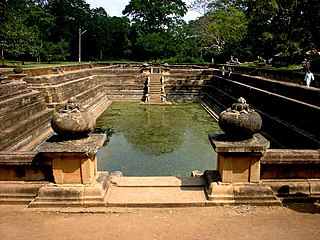
Anuradhapura is a major city in Sri Lanka. It is the capital city of North Central Province, Sri Lanka and the capital of Anuradhapura District. Anuradhapura is one of the ancient capitals of Sri Lanka, famous for its well-preserved ruins of an ancient Sinhala civilization. It was the third capital of the kingdom of Rajarata, following the kingdoms of Tambapanni and Upatissa Nuwara.

Tourism in Sri Lanka is growing rapidly. For centuries, Sri Lanka has been a popular place of attraction for foreign travelers. The Chinese traveler Fa-Hien visited Sri Lanka as early as the 410's AD/CE, and in the twelfth century, Italian explorer Marco Polo claimed Sri Lanka to be the "best island of its size in the world".
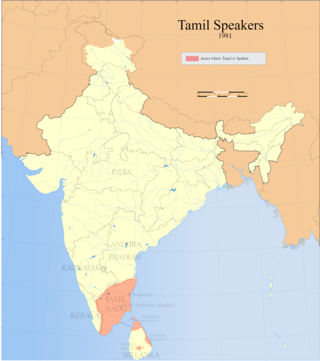
Sri Lankan Tamils, also known as Eelam Tamils, Ceylon Tamils or simply Tamils, are members of the Tamil ethnic group native to the South Asian island state of Sri Lanka. Today, they constitute a majority in the Northern Province, live in significant numbers in the Eastern Province and are in the minority throughout the rest of the country. 70% of Sri Lankan Tamils in Sri Lanka live in the Northern and Eastern provinces.
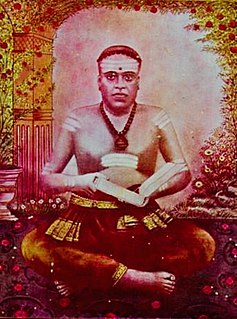
Arumuka Navalar was a Sri Lankan Shaivite Tamil language scholar, polemicist, and a religious reformer who was central in reviving native Hindu Tamil traditions in Sri Lanka and India.

St. John's College is a private school in Jaffna, Sri Lanka. Founded in 1823 by British Anglican missionaries, it is one of Sri Lanka's oldest schools.
Village deities are a common feature of the Hindu pantheon of deities. They are known as Gramadevatas. Each Hindu region and caste of India and South Asia has its share of village deities. Sri Lankan Tamils venerate their own group of village deities throughout Sri Lanka, specifically in the Tamil-dominated north and east of the island nation.
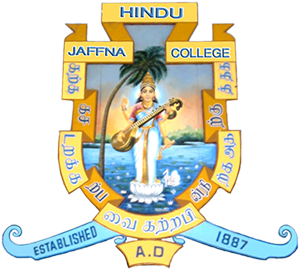
Jaffna Hindu College is a national school in Jaffna, Sri Lanka. It was founded in 1886 by a group of Hindu people who wanted an English language alternative to the Christian missionary schools.
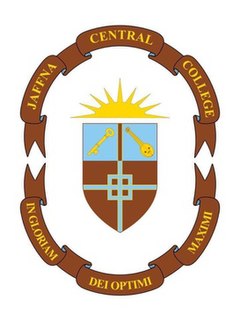
Jaffna Central College is a national school in Jaffna, Sri Lanka. Founded in 1816 by British Methodist missionaries, it is one of Sri Lanka's oldest schools.
Sri Lankan Tamil literature or Ceylon Tamil literature refers to Tamil literature produced in the current day country of Sri Lanka by various Tamil speaking communities such as the Sri Lankan Tamils, Indian Tamils of Sri Lanka and Sri Lankan Muslims. The earliest extant records survived from the Sangam age academies and continued in the medieval era in the courts of the Jaffna kingdom until modern times. The destruction of the Saraswathy Mahal library of Nallur and the burning of Jaffna library led to the loss of a large tract of Sri Lankan Tamil literature, although much survives through oral traditions and the unearthing and preservation of palm-leaf manuscripts, copper plate inscriptions & stone inscriptions.
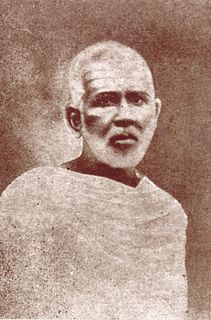
Chunnakam Kumaraswamy Pulavar was a well-known Sri Lankan Tamil scholar and poet from Maylani village in Chunnakam township in Jaffna peninsula in the British held Ceylon now known as Sri Lanka. He lived from 1854 to 1922. He along with other activists were instrumental in the revival of native traditions in Sri Lanka that had been long dormant during the previous 400 years of colonial rule by various European powers.

National Museum of Colombo, also known as the Sri Lanka National Museum is one of two museums in Colombo. It is the largest museum in Sri Lanka. It is maintained by the Department of National Museum of the central government. The museum holds contains a collections of much importance to Sri Lanka such as the regalia of the country, including the throne and crown of the Kandyan monarchs as well as many other exhibits telling the story of ancient Sri Lanka.
Sri Lankan Vellalar is a caste found in Sri Lanka, who comprise about half of the Sri Lankan Tamil population. They were traditionally involved in agriculture, but also included merchants, landowners and temple patrons. They also form part of the Sri Lankan Tamil diaspora.

Nainativu, is a small but notable island off the coast of Jaffna Peninsula in the Northern Province, Sri Lanka. The name of the island alludes to the folklore inhabitants, the Naga people. It is home to the Hindu shrine of Nagapooshani Amman Temple; one of the prominent 64 Shakti Peethas, and the Buddhist shrine Nagadeepa Purana Viharaya.

The American Ceylon Mission (ACM) to Jaffna, Sri Lanka started with the arrival in 1813 of missionaries sponsored by the American Board of Commissioners for Foreign Missions (ABCFM). The British colonial office in India and Ceylon restricted the Americans to the relatively small Jaffna Peninsula for geopolitical reasons for almost 40 years. The critical period of the impact of the missionaries was from the 1820s to early 20th century. During this time, they engaged in original translations from English to Tamil, printing, and publishing, establishing primary, secondary and tertiary educational institutions and providing health care for residents of the Jaffna Peninsula. These activities resulted in many social changes amongst Sri Lankan Tamils that survive even today. They also led to the attainment of a lopsided literacy level among residents in the relatively small peninsula that is cited by scholars as one of the primary factors contributing to the recently ended civil war. Many notable educational and health institutions within the Jaffna Peninsula owe their origins to the missionary activists from America. Missionaries also courted controversy by publishing negative information about local religious practices and rituals.

Tellippalai or Thellippalai is a small town in the northern Jaffna District of Sri Lanka. It is located about 15 kilometers north of Jaffna town along the Kankesanthurai road

Jaffna is the capital city of the Northern Province of Sri Lanka. It is the administrative headquarters of the Jaffna District located on a peninsula of the same name. With a population of 88,138 in 2012, Jaffna is Sri Lanka's 12th most populous city. Jaffna is approximately six miles from Kandarodai which served as an emporium in the Jaffna peninsula from classical antiquity. Jaffna's suburb Nallur, served as the capital of the four-century-long medieval Jaffna Kingdom.
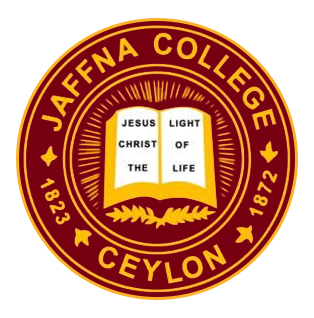
Jaffna College is a private school in Vaddukoddai, Sri Lanka. It was founded in 1871 as a successor to the Batticotta Seminary which had been established by American missionaries.

The Methodist Church of Sri Lanka and in is a Protestant Christian denomination in Sri Lanka. Its Headquarters is in Colombo and was established on 29 June 1814. It is a member of the World Council of Churches, the Christian Conference of Asia, the National Christian Council of Sri Lanka and the World Methodist Council.

Kadurugoda Viharaya is an ancient Buddhist temple situated in Chunnakam, Jaffna District, Sri Lanka. The temple is located in a small hamlet called Kandarodai and it is one of the few Buddhist temples remaining in Jaffna today. Currently this temple has been declared as an archaeological site in Sri Lanka and is maintained by the Sri Lankan army.

Velupillai Suppiah Thurairajah was a Sri Lankan Tamil architect who designed many buildings in Sri Lanka and abroad.




















